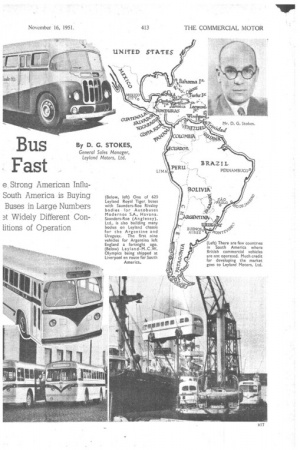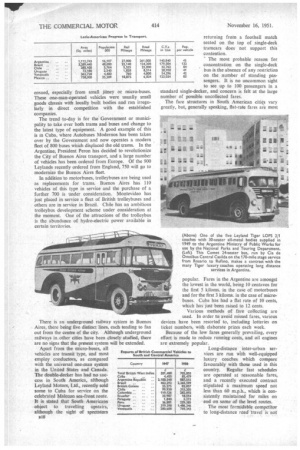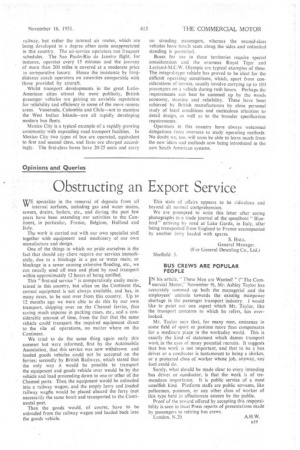South Americi System Develo Bus Fast
Page 50

Page 51

Page 52

Page 53

If you've noticed an error in this article please click here to report it so we can fix it.
By D. G. STOKES,
General Sales Manager, Leyland Motors, Ltd.
e Strong American InfluSouth America is Buying Buses in Large Numbers Widely Different Contalons of Operation
THERE HERE is a popular saying that mad dogs and Englishmen go out in the midday sun. By contrast, the characteristic and reasonable Latin American habit of taking a siesta has had a marked effect on public transport. Most of the city stores and offices close for a couple of hours around noon, which means that people go home for lunch, thus creating rush hours at midday, in addition to the normal morning and evening traffic peaks experienced in Great Britain. Moreover, there is pronounced late evening traffic to and from• theatres and sports centres, and most city transport goes on until midnight or even later. .
The South American Continent comprises many different republics, each of which has its own peculiarities and problems, and in a short article such as this, it is possible only to generalize. These growing and rich communities are developing their roads and industries at great speed, accompanied by a vast development of road passenger transport on city and inter-urban routes. Since 1940, the number of buses in use throughout the world has grown by 146 per cent., and Latin America is one of the main contributors to this remarkable increase.
An accompanying table (page 414) gives an indication of the progress that has already been made in developing communications in relation to the size and population of some of the principal countries concerned.
Snow ' and. Jungle .
In considering passenger road transport developments in the various countries of South America, it must be" realized that the •physical features and conditions 'of each territory vary considerably—from the snow-capped Andes to the dense, humid tropical forests found in the Amazon regions. Much of Argentina is flat pampas covered by magnificent fiat graded modern highways . on which high speeds for inter-city bus transport are the order of the day.
in Brazil, on the other hand, transport of allsorts continues to be a major problem as, except in the far north, the interior of the country is divided from the coast line by mountain ranges. . Nevertheless, under Federal and State plans, new roads are being developed -rapidly. One such road is the recently completed high . .
. way between the two most important Brazilian cities of .•Sao Paulo r and Rio de Janeiro; an example of engineer-. ing .ingenuityof ,which the Brazilians can be justly proud,' and Which will open up new possibilities of road
transport • " .
The influence of: the United States by physical ....'pii:P.. iirni:ty...'fil.rns' and . 'other modern propaganda is rria*ed:and it..7iS;iipt unnatural. that the transit type,of . IVO:fele= so popular in the •U.S.A 7 .meets with ., a re0y reception in most South. American. countries, As each . B i 6
country develops economically, so does the type of tran,sport develop from the lighter type vehicle to the latest underfloor-engined bus . operated by modern companies and municipalities.
An interesting feature of South American bus operation, not often found in Europe, is the co-operative organization. The companies such as C.U.T.C.S.A., of Montevideo, or Aliados, of Cuba, are compiised of numerous individuals who, in many cases, own and drive their own vehicles. Receipts are pooled and all purchasing and negotiations are carried out by .a central board nominated by popular vote. These confpanies run on regular routes, and have proper fare schedules, and all the vehicles are painted to a common colour scheme. These co-operatives are generally efficient, although there is a growing tendency to-day for them to be displaced by numicirial operation.
Practically all major South American cities have tramways, which are for the most part obsolete and are being replaced-by modern oil-engined bus fleets. These tramways were generally operated by foreign utility companies which invested. their money in this farm of
. .
enterprise. As the utility companies had flied fares which were difficult to alter, and received little or no protection from local busoperators, much competition ensued, especially from small jitney or micro-buses. These one-man-operated vehicles were usually small goods chassis with locally built bodies and ran irregularly in direct competition with the established companies. The trend to-day is for the Government or municipality to take over both trams and 'buses and change to the latest type of equipment. A good example of this is in Cuba, where Autobuses Modernos has been taken over by the Government and now operates a modem fleet of 800 buses which displaced the old trams. In the Argentine, President Peron has decided to revolutionize the City of Buenos Aires transport, and a large number of vehicles has been ordered from Europe. Of the 900 Leylands recently ordered from England, 750 will go to modernize the Buenos Aires fleet.
In addition to motorbuses, trolleybuses are being used as replacements for trams. Buenos Aires has 110 vehicles of this type in service and the purchase of a further 700 is under consideration. Montevideo has just placed in service a flect of British trolleybuses and others are in service in Brazil. Chile has an ambitious trolleybus development scheme under consideration at the moment. One of the attractions of the trolleybus is the abundance of hydro-electric power available in certain territories.
There is an underground railway system in Buenos Aires, there beingfive distinct lines, each tending to fan out from the centre of the city. Although underground railways in other cities have been closely studied, there are no signs that the present system will be extended.
Apart from the micro-buses, all vehicles are transit type, and most employ conductors; as compared with the universal one-man system in the United States and Canada. The double-decker has had no success in South. America, although Leyland Motors, Ltd., recently sold some to Cuba for service on the celebrated Malecon sea-front route. It is stated that South Americans object to travelling upstairs, although the sight of spectators.
returning from a football match seated on the top of single-deck tramcars does not support this contention.
' The most probable reason for concentration on the single-deck bus is the absence of any restriction on the number of standing passengers. It is no uncommon sight to see up to 100 passengers in a standard single-decker, and concern is felt at the large number of possible uncollected fares.
The fare structures in South American cities vary greatly, but, generally speaking, flat-rate fares are most
140,840 45 179,584 132 32,762 134 20,950 41 54,296 42 123,034 83
popular. Fares in the Argentine are amongst the lowest in the world, being 10 centavos for the first 5 kiloms, in the case of motorbuses and for the first 3 kiloms in the case of microbuses. Cuba has had a flat rate of 10 cents, which has just been raised to 12 cents.
Various methods of fare collecting are used. In order to avoid missed fares, various devices have been resorted to, including lotteries onticket numbers, with elaborate prizes each week.
Because of the low fares generally prevailing, every effort is made to reduce running costs, and oil engines are extremely popular.
Long-distance inter-urban services are run with well-equipped luxury coaches which compare favourably with those used in this country. Regular fast schedules are operated at reasonable fares, and a recently executed contract stipulated a maximum speed not less than 60 m.p.h., which is consistently maintained for miles on end on some of the level routes.
The most formidable competitor to long-distance road 'travel is not railway, but rather the internal air routes, which are being developed to a degree often quite unappreciated in this country. The air-service operators run frequent schedules, The Sao Paulo-Rio de Janeiro flight, for instance, operates every 15 minutes and the journey of more than 200 miles is covered at a moderate price in comparative luxury. Hence the insistence by longdiStance coach operators on amenities comparable with Those provided by aircraft.
Whilst transport developments in the great LatinAmerican cities attract the most publicity, British passenger vehicles are gaining an enviable reputation for reliability and efficiency in some of the more remote areas. Venezuela. Colombia and Chile—not to mention the West Indian Islands—are all rapidly developing modern bus fleets.
Mexico City is a typical example of a rapidly growing cornmunity with expanding road transport facilities. In Mexico City. two types of bus are operated, equivalent to first and second class, and fares are charged accordingly. The first-class buses have 20-25 seats and carry
no standing passengers, whereas the second-class vehicles have bench seats along the sides and unlimited standing is permitted.
Buses for use in these territories require special consideration and the overseas Royal Tiger and Leyland-M.C.W. Olympic are typical examples of these. The integral-type vehicle has proved to be ideal for the difficult operating conditions, which, apart from considerations of terrain, usually involve carrying up to 109 passengers on a vehicle during rush hours. Perhaps the requirements can best be summed up by the wmds economy, stamina and reliability. These have been achieved by British manufacturers by close personal study of local conditions and meticulous attention to detail design, as well as to the broader specification requirements.
Operators in this country have always welcomed delegations from overseas to study operating methods. No doubt we; too, will soon be able to learn much from the new ideas and methods now being introduced in the new South American systems.




































































































